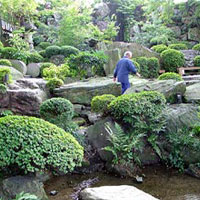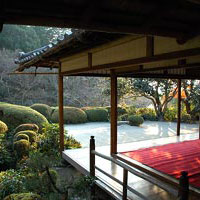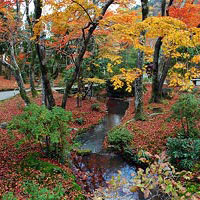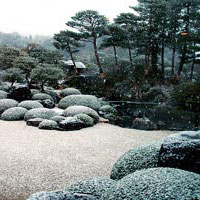Being in the Garden: Four Vignettes From a Traveler to Japan
I. Dancing in the Dark

With the nimbleness of a deer, Yoshimi-san skipped lightly through the nighttime garden. The paths, with their rough-textured, uncut, unevenly spaced stepping-stones, wound up and down the steep slopes of the Ganko restaurant's large garden in Kyoto. Suspended high above, on a black-velvet sky amid a scattering of stars was a tiny white pearl of a full moon.
Low lanterns—spaced widely apart along the paths—spread pools of warm yellow luminescence into deep shadows. The garden I had seen a few weeks earlier in bright midday now seemed mysterious, concealing its loveliest secrets, enticing us to explore.
Some 40 years older than Yoshimi-san, I reined in any desire for swift movement in the garden. Naoko-san, administrator at the Kyoto Japanese Language School, where I had been taking Japanese lessons from Yoshimi-san, lingered back with me.
We followed Yoshimi-san down a path that culminated at a waterfall. The water trickled across the face of tall, dark stones, glistening sporadically in the dim reflected lantern light. Low, rounded shrubs—boxwood, azalea, enkianthus—bright green in daylight, were now dark silhouettes crouched along either side of the paths, like slumbering animals waiting for the dawn.
Yoshimi-san is a brilliant teacher, but before we met, she couldn't remember having visited any of the many beautiful gardens in Kyoto, though she was a native of that city, a true Kyoto-jin. But now she came tripping lightly back up the stepping-stones, laughter coloring her speech, bringing us the gift of her delight. This was something new for her. And seeing her dancing through the darkened garden that evening—though I had visited some 75 gardens in Japan—there was something new for me as well.
II. From a Still Point

One bright, clear morning in fall, I found myself sitting alone under the wisteria arbor (fujidana) in the lower garden of Shisendo, "the Poet-Hermit's Hall." I had been attracted by the rather romantic story of samurai-turned-poet Ishikawa Jozan (1583–1672). Although as a young man he had fought in important battles for the Tokugawa clan, in later life he retired and built this Kyoto retreat. Here, he passed the last three decades of his life, writing poetry in Chinese (kanshi), practicing calligraphy, and making a list of the 32 greatest poets in Chinese history. The garden figures prominently in many of his poems:
Early in the morning I sweep with tattered broom; not a speck of dust remains along the path. I sit so long I can watch the flowers bloom…
And so, from this still point under the arbor, wondering what it must have been like for Jozan in such a different world, I too wrote about his garden:
A mourning dove, all delicate tints of rose, azure, and umber, waddles by at my feet, head bobbing, pecking here and there at something only it can see. Just a few large white flowers tinged in pink still remain on the nearby rose mallow tree. High-pitched birdcalls whistle down from the woods of the foothills. A tiny brown ant rushes past on the ground below, stops for a moment to check out a dead leaf that had dropped from the mallow tree. Though a bit of faded gold to me, the leaf is of no apparent interest to the ant, which rushes on.
From a far corner, a deer scarer's (shishi-odoshi) vibrant CLONK reverberates through the garden every half minute or so. Time still exists, it says. Yet that lovely hollow sound of bamboo striking stone, once supposedly used to scare off deer and wild boars, seems now to contain echoes of eternity within it. To the east and north, the woods rise up the slopes of the Higashiyama district, presenting a more "wild" scene. Here in the garden, the work of the human mind and hand is everywhere, both in what is carefully articulated, and in what is respectfully left alone.
This garden teaches you that the word "retreat" can mean something like its opposite: an entry into "another world," or rather into our deeper connections with this world we find ourselves in.
III. Being There

Hougon-in is a lovely garden in a temple nestled in the western foothills of Kyoto. It was particularly lovely when I visited early in December.
As I entered the garden, I glanced at the single sheet of text handed out when one pays the entrance fee:
Within the garden, we find a man-made hill depicting the Buddhist holy mountain, Mt. Sumeru, in the background. In the foreground, there is a wide area representing this mundane world of suffering, and in the middle ground is a set of three stones called the "Above the Clouds" stone triad. Within the foreground "sea" area, there is placed a boat-shaped stone, which is a symbolic vehicle for crossing over from this mundane world to the spiritual world.
It was a rather cool afternoon, and groups of Japanese visitors milled about, marveling, as I was, at the lovely colors above and underfoot. None of them seemed to be reading the handout. I put the handout in my bag and looked about me.
A few paths meandered through a wood of Japanese maples, past a low teahouse of unpainted cypress and translucent paper shoji windows. Russet, gold, burnt orange, and brilliant red foliage glowed among the branches against the clear sky above and carpeted the earth below. The path wound along and occasionally crossed a winding stream (yarimizu), whose trickling waters sketched a glistening black calligraphic line through the brilliantly colored fallen leaves. It was like walking through a dream, as if the garden itself flowed into mind and body.
We grope for words—"peaceful," "tranquil," "spiritual," "serene"—and are frustrated by the inadequacy of language to describe, let alone explain, these experiences in the gardens of Japan. It is no wonder that some have imposed a metaphysic of one kind or another—mysticism, religious symbolism, Zen philosophy—on those experiences. Yet, trying to look beyond the physical may be missing the point. Instead, take time to see, to listen, and to feel the garden: Be there.
IV. An Interplay of Opposites

It was the last day of the year. My wife, Michèle, and I were just finishing breakfast at our inn in Yasugi, Shimane Prefecture, when Wataru Takeda-san, director of public relations at the Adachi Museum, telephoned to invite us across the street to see the museum gardens in the snowfall. It was early in the morning, and the museum was closed, but Wataru-san met us at the entrance. I raced through the various wings of the building, taking photos as fast as I could, when suddenly, pausing by the huge windows of the Midori coffee café, I said to myself, "Hold on. Stop taking pictures and look."
The snow floated down, spreading a thin layer of semitransparent white over the grounds, the pines, the shrubs, and the stones, whose distinctive colors were muted into deep tones of black, gray, and umber. The mountains beyond the garden were disappearing in a thick, swirling mist. Although I had seen this same garden many times under different lights, in different seasons and weathers, it was as if a whole new world was opening up before my eyes. The garden seemed to call out to me, working its quiet magic, tugging at mind and body.
Art historian Kendall H. Brown finds in the works of shin-hanga woodblock print artists "a relationship between man and nature that is harmonious as well as tranquil." He also notes a confluence in these works of "stolidity and grace," "ordinary and orphic," and the "familiar yet strange." Much the same can be said of the best Japanese gardens.
One often finds in them an interplay of features that we are used to thinking of as mutually exclusive. Consider, for example, the way the gardens are brought right up to the dwellings, and how those dwellings—through the manipulation of sliding panels—can be opened to let the garden "in," thus blurring the boundary between inside and outside. Consider how natural materials—stone, water, coarse sand, and plants—are shaped and arranged so that the human touch is evident, but unostentatiously so. Wood fences or compressed mud walls may shield the garden from outside, yet often they are low enough so that those in the garden can see a view of mountains or forests well beyond—and the wilderness is part of the experience.
Opposites are brought into equilibrium, but in the best gardens, this equilibrium is anything but static. Rather, it is informed throughout with a dynamic and delicate tension. For the visitor, the result can be a magical feeling that is both tranquil and intense, of a heightened consciousness of that potential for a harmonious relationship to nature and to our own humanity.
Yoshimi-san, as she tripped lightly through the garden of the Ganko restaurant that night in Kyoto, must have had this recognition as well.


